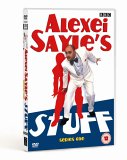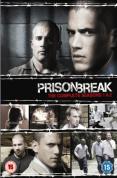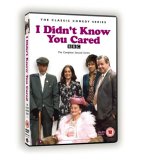![Men Behaving Badly - Series 2 [1992]](/pictures/1016289.jpg) Men Behaving Badly - Series 2 | DVD | (05/06/2000)
from £3.74
| Saving you £16.25 (434.49%)
| RRP
Men Behaving Badly - Series 2 | DVD | (05/06/2000)
from £3.74
| Saving you £16.25 (434.49%)
| RRP The ultimate small-screen representation of Loaded-era lad culture--albeit a culture constantly being undermined by its usually sharper female counterpart--there seems little argument that Men Behaving Badly was one of 1990s' definitive sitcoms. Certainly the booze-oriented, birds-obsessed antics of Martin Clunes' Gary and Neil Morrissey' Tony have become every bit as connected to Britain's collective funny bone as Basil Fawlty's inept hostelry or Ernie Wise's short, hairy legs. Yet, the series could easily have been cancelled when ITV viewers failed to respond to the original version, which featured Clunes sharing his flat with someone named Dermot, played by Harry Enfield. Indeed, it was only when the third series moved to the BBC and was then broadcast in a post-watershed slot--allowing writer Simon Nye greater freedom to explore his characters' saucier ruminations--that the show began to gain a significant audience. By then, of course, Morrissey had become firmly ensconced on the collective pizza-stained sofa, while more screen time was allocated to the boys' respective foils, Caroline Quentin and Leslie Ash. Often glibly dismissed as a lame-brained succession of gags about sex and flatulence, the later series not only featured great performances and sharp-as-nails writing but also sported a contemporary attitude that dared to go where angels, and certainly most other sitcoms, feared to tread. Or, as Gary was once moved to comment about soft-porn lesbian epic Love in a Women's Prison: "It's a serious study of repressed sexuality in a pressure-cooker environment." Series 2 includes: "Gary and Tony", in which Tony moves into the Gary's flat and makes his first disastrous attempt to woo upstairs-neighbour Deborah; "Rent Boy" in which Gary thinks Tony is gay; "How to Bump Your Girlfriend" in which no sooner has Tony got back together with his old girlfriend and filled her in about Gary ("nice bloke, ears like the FA Cup") than he decides to give her the shove; "Troublesome Twelve Inch" in which Gary tries to sell a rare record belonging to Dorothy without her knowing; "Going Nowhere" in which Tony buys a van to impress Deborah who in turn gets stuck in a lift with Gary; and "People Behaving Irritatingly" in which Tony's brother and missus visit the flat much to Gary's annoyance ("It's not enough that they were at it all last night, now they're trying to set up a national sperm bank in my bath.) --Clark Collis
 Puppetmaster (DVD) | DVD | (20/08/2012)
from £15.38
| Saving you £-2.39 (-18.40%)
| RRP
Puppetmaster (DVD) | DVD | (20/08/2012)
from £15.38
| Saving you £-2.39 (-18.40%)
| RRP Alex Whittaker and three other gifted psychics are investigating rumors that the secret of life has been discovered by master puppeteer Andre Toulon. But the psychics quickly discover Toulon's secret of death in the form of five killer puppets - each one uniquely qualified for murder and mayhem. Tunneler has a nasty habit of boring holes in people with his drill bit head. Ms. Leech regurgitates killer leaches that suck her victims dry. Pinhead strangles his enemies with his powerful vice-like hands. Blade has a gleaming hook for one hand and a razor-sharp knife for the other. And Jester, the ruthless brains of the bunch, is absolutely merciless. Together, they're an army of skilled assassins, diabolically programmed to guard the deadly secrets of the Puppet Master.
 DV8 - The Cost Of Living | DVD | (27/02/2006)
from £19.75
| Saving you £-4.76 (N/A%)
| RRP
DV8 - The Cost Of Living | DVD | (27/02/2006)
from £19.75
| Saving you £-4.76 (N/A%)
| RRP ""The Cost of Living"" was shot on location in Cromer on the Norfolk Coast in England: a typical old-fashioned and faded seaside resort. The summer season has petered to an end and an air of desertion hangs over the town. Eddie and David are disillusioned street performers. Eddie is tough confrontational and not afraid to defend his belief in justice and honesty. David is a dancer who has no legs; watching him makes you reconsider accepted notions of perfection. He is quietly determin
![Zack Snyder's Justice League (4K Ultra HD) [Blu-ray]](/pictures/1156563.jpg) Zack Snyder's Justice League (4K Ultra HD) | Blu Ray | (27/05/2021)
from £34.81
| Saving you £N/A (N/A%)
| RRP
Zack Snyder's Justice League (4K Ultra HD) | Blu Ray | (27/05/2021)
from £34.81
| Saving you £N/A (N/A%)
| RRP ![Happy Feet Two - Triple Play (Blu-ray + DVD + Digital Copy)[Region Free]](/pictures/1114211.jpg) Happy Feet Two - Triple Play (Blu-ray + DVD + Digital Copy | Blu Ray | (26/03/2012)
from £6.84
| Saving you £18.15 (265.35%)
| RRP
Happy Feet Two - Triple Play (Blu-ray + DVD + Digital Copy | Blu Ray | (26/03/2012)
from £6.84
| Saving you £18.15 (265.35%)
| RRP The sequel to Happy Feet, the Academy Award-winning animated smash hit, Happy Feet Two returns audiences to the magnificent landscape of Antarctica. Mumble, The Master of Tap, has a problem because his tiny son, Erik, is choreo-phobic. Reluctant to dance, Erik runs away and encounters The Mighty Sven - a penguin who can fly! Mumble has no hope of competing with this charismatic new role model. But things get worse when the world is shaken by powerful forces. Erik learns of his father's 'guts and grit' as Mumble brings together the penguin nations and all manner of fabulous creatures - from tiny Krill to giant Elephant Seals - to put things right. Special Features: How To Draw A Penguin The Mighty Sven: Happy Feet 2 Sing-A-Long Bridge of Life: Happy Feet 2 Sing-A-Long Papa Oom Mow Mow: Happy Feet 2 Sing-A-Long Running With Boadicea Pink's New Song The Amazing Voices of Happy Feet 2 I Tawt I Taw A Puddy Tat Happy Feet 2 Movie App Helping Penguins and Pals
![Bless This House [1972]](/pictures/1015245.jpg) Bless This House | DVD | (07/07/2003)
from £N/A
| Saving you £N/A (N/A%)
| RRP
Bless This House | DVD | (07/07/2003)
from £N/A
| Saving you £N/A (N/A%)
| RRP The movie of the successful TV series in which two arguing families discover that their respective offsprings have been having a secret affair and plan to marry...
 Alexei Sayle's Stuff | DVD | (05/09/2005)
from £N/A
| Saving you £N/A (N/A%)
| RRP
Alexei Sayle's Stuff | DVD | (05/09/2005)
from £N/A
| Saving you £N/A (N/A%)
| RRP This DVD features the popular Liverpudlian comedian in his pomp; a winning combination of Pythonesque surrealism and 'alternative' comedy philosophy honed with a satirical edge.
![Confessions - Confessions Of A Window Cleaner/Confessions Of A Driving Instructor/Confessions From A Holiday Camp/Confessions Of A Pop Performer [DVD]](/pictures/1104473.jpg) Confessions - Confessions Of A Window Cleaner/Confessions Of A Driving Instructor/Confessions From A Holiday Camp/Confessions Of A Pop Performer | DVD | (20/09/2010)
from £N/A
| Saving you £N/A (N/A%)
| RRP
Confessions - Confessions Of A Window Cleaner/Confessions Of A Driving Instructor/Confessions From A Holiday Camp/Confessions Of A Pop Performer | DVD | (20/09/2010)
from £N/A
| Saving you £N/A (N/A%)
| RRP The 'Confessions' series of films are still entertaining examples of 70s British high camp and go to places the 'Carry On' films never dared! Confessions Of A Window Cleaner (1974): The classic bawdy British sex comedy about a window cleaner who doesn't quite clean up his act... Confessions Of A Driving Instructor (1973): Our randy young hero Timmy Lea progresses from the 'ins and outs' of window cleaning to the joys of 'gear shifting' as he sets himself up as a driving instructor. Guaranteed 0 to 60 in 5 seconds...blonde or brunette! Confessions From A Holiday Camp (1977): Timmy and Sid are entertainment officers at a holiday camp. They must organise a beauty contest successfully or find themselves out of work! Confessions Of A Pop Performer (1975): Hilarious antics a-plenty when Tommy and Sid take on a second-rate pop group and end up on a Royal Charity Show!
![Look-Back on 70s Telly - Issue 3 [DVD]](/pictures/1129322.jpg) Look-Back on 70s Telly - Issue 3 | DVD | (02/05/2013)
from £13.98
| Saving you £3.00 (25.02%)
| RRP
Look-Back on 70s Telly - Issue 3 | DVD | (02/05/2013)
from £13.98
| Saving you £3.00 (25.02%)
| RRP Back in the day when childrens' programmes were, by turns, fun, challenging, dramatic, spooky, hilarious and fantastic, tea-time programming was a staple part of the lives of millions of kids. Diverse and highly popular, it fired imaginations and was invariably an integral part of any worthwhile playground antics the next day.
![Jumanji [1995]](/pictures/1036235.jpg) Jumanji | DVD | (23/01/2006)
from £5.94
| Saving you £7.05 (118.69%)
| RRP
Jumanji | DVD | (23/01/2006)
from £5.94
| Saving you £7.05 (118.69%)
| RRP It's a jungle in there! When young Alan Parrish and his friend Sarah (Bonnie Hunt) begin to play a mysterious board game they don't realise its unimaginable powers until Alan is magically transported into the untamed jungles of Jumanji. Twenty-six years later Judy (Kirsten Dunst) and Peter (Bradley Pierce) discover the dusty board and reawaken the game as they begin to play. Instantly the forces of Jumanji release a fully-grown bewildered Alan Parrish (Robin Williams) into
 Prison Break - Series 1-2 - Complete | DVD | (19/11/2007)
from £N/A
| Saving you £N/A (N/A%)
| RRP
Prison Break - Series 1-2 - Complete | DVD | (19/11/2007)
from £N/A
| Saving you £N/A (N/A%)
| RRP Michael Scofield is a desparate man in a desparate situation - his brother has been convicted of murder and is on death row. Despite the evidence against Lincoln Michael is convinced of his brother's innocence. With no other options and the clock ticking towards Lincoln's execution Michael holds up a bank to get himself incarcerated alongside his brother. Once inside Michael - a structural engineer with the blueprints for the prison tattooed on his body - has hatched an elaborate plan to break Lincoln out and prove that he was framed.
![What's The Worst That Could Happen? [2002]](/pictures/1015622.jpg) What's The Worst That Could Happen? | DVD | (23/09/2002)
from £4.94
| Saving you £13.05 (264.17%)
| RRP
What's The Worst That Could Happen? | DVD | (23/09/2002)
from £4.94
| Saving you £13.05 (264.17%)
| RRP What's the worst that could happen? Probably being forced to watch What's the Worst That Could Happen? from start to finish without a pause button: it's more lame than a three-legged dog. The plot is straightforward enough: two men, each as crooked as the other, come into conflict when petty thief Kevin Caffrey (Martin Lawrence) breaks into the apparently unoccupied beach house of wealthy and unscrupulous businessman Max Fairbanks (Danny DeVito). The house turns out not to be empty: Fairbanks calls the cops, claims that Caffrey has stolen his ring and coolly claims it back in front of his uniformed audience. It's a ring that Caffrey values because it has just been given to him by his new girlfriend Amber (Carmen Ejogo). He's so desperate to get it back that he hounds Fairbanks through the rest of the film, breaking into various Fairbanks properties as he goes. Words like "zany" and "madcap" could be used in the interests of charity, but actually the film falls flat on its face. Lawrence is certainly no Eddie Murphy and the plot would need an injection of major talent to give it a chance. DeVito yet again relies on his stature to provide the laughs. John Leguizamo plays Caffrey's sidekick as best he can but the fake sheikhs-in-tea-towels scene induces more groans than laughs. This is one for diehard fans of the lead actors only. On the DVD: What's the Worst That Could Happen? comes to DVD with a choice of two spoken languages (English or French) and many subtitle options. There's also a generous selection of outtakes, an alternative ending, a music video ("Music" by Erick Sermon) and the original theatrical trailer. It's just a shame that the film itself isn't better. --Harriet Smith
![Supernova - Steelbook [Blu-ray]](/pictures/1162761.jpg) Supernova - Steelbook | Blu Ray | (25/05/2023)
from £N/A
| Saving you £N/A (N/A%)
| RRP
Supernova - Steelbook | Blu Ray | (25/05/2023)
from £N/A
| Saving you £N/A (N/A%)
| RRP ![The Congress [Blu-ray]](/pictures/1132815.jpg) The Congress | Blu Ray | (08/12/2014)
from £N/A
| Saving you £N/A (N/A%)
| RRP
The Congress | Blu Ray | (08/12/2014)
from £N/A
| Saving you £N/A (N/A%)
| RRP An ageing actress (Robin Wright, playing a version of herself) decides to take her final job: preserving her digital likeness for a future Hollywood.
 I Didn't Know You Cared - The Complete Second Series | DVD | (22/05/2006)
from £25.97
| Saving you £-5.98 (N/A%)
| RRP
I Didn't Know You Cared - The Complete Second Series | DVD | (22/05/2006)
from £25.97
| Saving you £-5.98 (N/A%)
| RRP From the books of Peter Tinniswood comes one of television's greatest comedy families The Brandons. There's miserable pessimist Uncle Mort his sharp-tongued sister Annie who is constantly arguing with husband Les their laid-back son Carter and his not so laid-back fianc Pat and finally old Uncle Stavely who carries his friend's ashes around his neck in a box and only enters the constant bickering with a cry of 'I 'eard that! Pardon?' Pat is desperately trying to turn reluctant C
![The Europeans [1979]](/pictures/1019267.jpg) The Europeans | DVD | (17/07/2006)
from £4.47
| Saving you £5.52 (123.49%)
| RRP
The Europeans | DVD | (17/07/2006)
from £4.47
| Saving you £5.52 (123.49%)
| RRP In 1850 a few miles outside Boston the household of the dour Mr. Wentworth receives two unannounced visitors from Europe Eugenia and Felix the daughter and son of his half sister. Gertrude one of Wentworth's two daughters is instantly infatuated with her cousins and trouble brews...
![Men Behaving Badly - Series 3 [1992]](/pictures/1016290.jpg) Men Behaving Badly - Series 3 | DVD | (05/06/2000)
from £4.90
| Saving you £15.09 (307.96%)
| RRP
Men Behaving Badly - Series 3 | DVD | (05/06/2000)
from £4.90
| Saving you £15.09 (307.96%)
| RRP The ultimate small-screen representation of Loaded-era lad culture--albeit a culture constantly being undermined by its usually sharper female counterpart--there seems little argument that Men Behaving Badly was one of 1990s' definitive sitcoms. Certainly the booze-oriented, birds-obsessed antics of Martin Clunes' Gary and Neil Morrissey's Tony have become every bit as connected to Britain's collective funny bone as Basil Fawlty's inept hostelry or Ernie Wise's short, hairy legs. Yet, the series could easily have been cancelled when ITV viewers failed to respond to the original version, which featured Clunes sharing his flat with someone named Dermot, played by Harry Enfield. Indeed, it was only when the third series moved to the BBC and was then broadcast in a post-watershed slot--allowing writer Simon Nye greater freedom to explore his characters' saucier ruminations--that the show began to gain a significant audience. By then, of course, Morrissey had become firmly ensconced on the collective pizza-stained sofa, while more screen time was allocated to the boys' respective foils, Caroline Quentin and Leslie Ash. Often glibly dismissed as a lame-brained succession of gags about sex and flatulence, the later series not only featured great performances and sharp-as-nails writing but also sported a contemporary attitude that dared to go where angels, and certainly most other sitcoms, feared to tread. Or, as Gary was once moved to comment about soft-porn lesbian epic Love in a Women's Prison: "It's a serious study of repressed sexuality in a pressure-cooker environment." Series 3 includes: "Lovers" in which Gary becomes worried that he hasn't slept with enough women; "Bed" in which Dorothy and Gary experience problems in the boudoir ("What's the matter? We always have sex after I've cooked for us. That's why I do it."); "Casual Ties" in which a depressed Deborah decides to sell her flat and go travelling, while Tony fails to cheer her up by impersonating different types of Cheese; "Weekend" in which Tony gets a job at The Crown; "Cleaning Lady" in which Tony reconsiders his professional options ("I could be an escort." "What, a car?" asks Gary); "Marriage" in which Gary joins Dorothy for a candlelit dinner ("Why she couldn't find a restaurant with proper lighting I don't know"). --Clark Collis
![Circle Of Two [1980]](/pictures/1020170.jpg) Circle Of Two | DVD | (24/09/2001)
from £N/A
| Saving you £N/A (N/A%)
| RRP
Circle Of Two | DVD | (24/09/2001)
from £N/A
| Saving you £N/A (N/A%)
| RRP True love knows no bounds. A rebellious 16 yr. old finds comfort in an ageing artist leading to an ill-fated romance where 2 people so wrong for each other are really so right.
![The Lost [DVD]](/pictures/1092681.jpg) The Lost | DVD | (08/06/2009)
from £8.99
| Saving you £7.00 (77.86%)
| RRP
The Lost | DVD | (08/06/2009)
from £8.99
| Saving you £7.00 (77.86%)
| RRP The Lost
 If These Walls Could Talk | DVD | (30/06/2003)
from £19.94
| Saving you £-13.95 (N/A%)
| RRP
If These Walls Could Talk | DVD | (30/06/2003)
from £19.94
| Saving you £-13.95 (N/A%)
| RRP Regardless of your opinion on the topic, If These Walls Could Talk is a bold and provocative examination of how the laws and attitudes about abortion in the United States have both changed drastically and remained so much the same. Three women, three time periods, one house: each finds herself in trouble and must face the overwhelming decision about what to do with the unwanted pregnancy. The first segment is the most powerful, featuring Demi Moore as a young, recently widowed nurse in 1952. With no-one to turn to and with limited financial means, her options are few. Catherine Keener costars as her harshly judgmental sister-in-law. The next piece occurs in 1974 as Sissy Spacek, a mother of four trying to earn a college degree, discovers she's pregnant with her fifth child. Her utterly modern feminist daughter encourages Spacek to get a newly legal abortion, but it's a complex decision. In the final segment, college student Anne Heche becomes pregnant by her married professor. Her best friend, played by Jada Pinkett, is resolutely against abortion and the two wrangle over right and wrong. As the young woman tries to learn about her options, she finds herself enmeshed in the pro-life demonstrations outside the abortion clinic. Cher, who directs this segment (the other two are directed by Nancy Savoca), costars as a doctor at the clinic. While trying to be even-handed and demonstrating the different choices different women make, the film does have a decidedly pro-choice leaning. Yet the power of the movie is undeniable and it raises significant questions on both sides of the abortion debate, making it an important film for women (and men) everywhere to watch and talk about. --Jenny Brown

Please wait. Loading...
This site uses cookies.
More details in our privacy policy